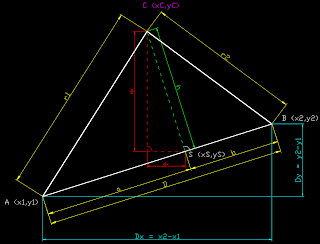To write a developing algorithm we need to get familiar with 2 topics from mathematical algebra .
3D coordinates and length of triangle sides |
First we need to know all 3 sides of triangle .
A triangle can be defined with 3 points . And every point can be described with 3 coordinates (x,y,z) .
Distance between two points is equal to square root from sum of squared differences between point coordinates . See picture .
Construction |
Next step is made in 2 dimensions . First we define a line between two points A and B . distance between those points is equal to length of a first side of triangle ( D on a picture ) . Other sides of a triangle have lengths of r1 and r2 . We are looking for point C with coordinates (xC; yC) .
First step is to find point S .
From Pythagorean theorem for triangles ACS and BCS we:get :
r1² = h² + a²
r2² = h² + b²
From difference between those two equations :
r1² - r2² = a² - b²
r1² -r2² = (a+b) * (a-b)
And because D = a + b and b = D - a
r1² -r2² = D * (2a-D)
Therefore :
a = (r1² -r2² +D²) / 2D
Point S has coordinates :
xS = x1 + (Dx * a) / D
yS = y1 + (Dy * a) / D
When we know a we can also calculate h : h = √(r1² - a²)
To be continued ...
we can also write down two dependencies :
Dy / D = dx / h => dx = - (Dy * h ) / D
( negative sign tells us that if Dy is positive(point B is above point A), then point C is to the left from point S and vice-verso )
Dx / D = dy / h => dy = (Dx * h ) / D
Last step is getting coordinates of point C :
xC = xS + dx = x1 + (Dx * a) / D - (Dy * h ) / D = x1 + (Dx * a - Dy * h ) / D
yC = yS + dy = y1 + (Dy * a) / D + (Dx * h ) / D = y1 + (Dy * a + Dx * h ) / D
There is also second possible point C' that is situated below line AB
xC' = xS + dx = x1 + (Dx * a) / D + (Dy * h ) / D = x1 + (Dx * a + Dy * h ) / D
yC' = yS + dy = y1 + (Dy * a) / D - (Dx * h ) / D = y1 + (Dy * a - Dx * h ) / D
To be continued ...



No comments:
Post a Comment